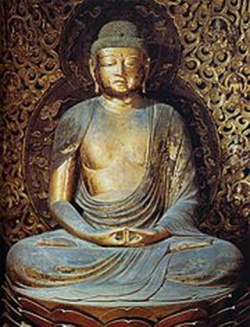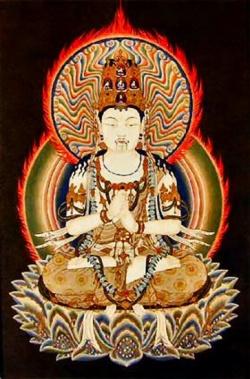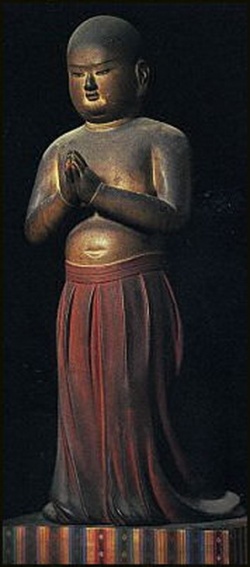Vinaya II
The Vinaya, one of the three divisions of the Buddhist scriptures, is the "basket" (pitaka) that spells out the rules for monks and nuns. It is therefore also referred to as the Vinaya-pitaka. It gains its authority from the belief that the Vinaya presents in a systematic fashion the precepts voiced by Sakyamuni Buddha for the conduct of those who assumed monastic orders. According to tradition, these rules were compiled soon after the Buddha's mahaparinirvana (death) and were then memorized. They were passed on orally until around 100 BCE, when they were written down.
Study of the Vinaya is important because it gives an insight into the way Buddhist practice developed over time. Although it may seem that much of the Vinaya is focused on codes and punishment for offenses, this simply reflects the actual occurrence of such issues, and the continuing influence of human nature on human institutions. Because of such transgressions and the efforts to deal with them we have a full picture of Buddhist values and monastic life.
The Vinaya in Theravada Cultures
The oldest texts of the Vinaya that have survived are written in Pali. They contain all the regulations that give structure to the life of the Theravada bhiksus (monks) and bhiksunis (nuns), as well as listing a number of procedures and conventions of etiquette that promote positive relationships within the monastic community, and between the monks and nuns and those lay people upon whom they rely for support. One part of the Vinaya, the Sutravibhanga, offers reflections on each rule and the rationale for its application. The existence of such material indicates that the rules were not just to be considered a matter of outward behavior but were part of the training of the mind.
As might be expected, over the first centuries of the Buddhist movement, as time passed and the movement spread around India and to Sri Lanka, variations in the oral Vinaya occurred, and these variations are manifested in the early Pali texts. [[Wikipedia: Thomas William Rhys Davids| Thomas William Rhys Davids]], founder of the Pali Text Society, made the translation of the Vinaya one of the initial tasks of the society. The original edition appeared in multiple volumes published by Clarendon Press (and more recently reprinted in several editions).
No complete Vinaya texts have survived in Sanskrit, the language used by the early Mahayana groups, but Chinese translations of four of the early Buddhist schools have survived. These texts contain a variety of differences both with the Pali Vinaya and with each other. One of these texts, The Fourfold Rules of Discipline, emerged as the primary text for several Chinese groups, collectively known as the Precepts school, the most notable branch being the Nanshan school. The volume contains 348 precepts divided into seven categories, beginning with the eight major unpardonable rules whose violation would cause one to be expelled from the monastic order, to a variety of lesser offenses. The Nanshan school was founded in the seventh century by Dao Xuan (596–667) who resided on Zhongnan Shan, the mountain that gave the school its name. Dao Xuan later wrote a commentary on the Fourfold Rules that served as the primary text for Nanshan practitioners.
A student of the Nanshan school, Jianzhoujian (Chien-chen, also known as Ganjin) migrated to Nara, Japan, in 753, and established a new school modeled on the Nanshan, which in Japan became known as the Ritsu school. Amid the several schools headquartered at Nara, the Ritsu was the one that primarily focused on the rules for the monastic life. The Ritsu-shu survives as a small sect of Japanese Buddhism, still headquartered in Nara. In the 13th century, a group that combines Shingon doctrines with observation of the Vinaya as found in the Fourfold Rules of Discipline was founded by Eizon (1201–90). It is headquartered at Saidai-ji temple in Nara.
There are traditionally three sections to this material: the Sutravibhanga, Skandhaka, and Parivara ("Appendices" or "Accessories"). This forms the Vinaya material proper. There are two additional types of Vinaya-related material, the paracanonical and the commentarial. The "paracanonical" Vinaya consists of the Pratimoksa/Patimokkha and the Karmavacana, two ancient works still in use in monasteries today.
The Pratimoksa is simply a collection of rules of conduct. These rules were designed to detail daily life in the monastery—such mundane areas as eating, cleaning, and assemblies. The Buddha ordered that the Pratimoksa be recited on every Posadha day, the celebrations that occurred twice each month during the full and new moon cycles. There were punishments spelled out for not following the rules—eight types for monks and seven for nuns.
A karmavacana was a formula used to follow through on sanghakarmas, or acts reflecting the Sangha's decision on general issues or disputes. Sanghakarmas required the presence of enough monks, consideration of all absentee ballots, proposal of a motion, and the final proclamation of the karmavacana.
Karmavacanas dealt with such important issues as admission, ordination, confession, preparation of medicines, discipline, dwellings, schisms, and relations between students and teachers. They provide a window on the democratic way the Buddhist Sangha operated.
Sutravibhanga
Vibhanga literally means "analysis." In the Vinaya the Sutravibhanga provides an analysis of the sections of the Pratimoksa. For each rule, the Sutravibhanga discusses stories illustrating the rule, the rule itself, a commentary, and stories concerning mitigating circumstances. The text also discusses additional offenses not included in the Pratimoksa: duskrta (light offenses), sthulatyaya (grave offenses), and durbhasita (offenses of improper speech).
Skandhaka
The Skandhaka involves acts and ceremonies important to the Sangha as a body. Just as the Sutravibhanga analyzes the Pratimoksa, the Skandhaka analyzes the Karmavacana. The Skandhaka is organized into 20 chapters, each focused on a single vastu, or subject area, such as admission to monkhood, confession, clothing, and food and medicine.
Noncanonical Commentaries
The Vinaya section of the Tripitaka was closed to amendments quite early in Buddhism's history. Because of that a massive commentarial literature grew as well, in many languages. The most famous Pali commentaries are those by Buddhaghosa. His Vamantapasadika is a commentary on the entire Vinaya. His Kankhavitarani is a commentary on the Pali Patimokkha (Pratimoksa).
Versions of the Vinaya
Theravada Sanghas, such as those in Sri Lanka, Burma, and Thailand, today follow the Pali version of the Vinaya. The Chinese and other East Asian Sanghas have five versions to choose from. And there is a Tibetan version.
The Chinese Buddhist monastic code is based overwhelmingly on one supplemental text, the Brahmajala Sutra (fanwang jing). This work was translated into Chinese by Kumarajiva in 406. It is in fact one chapter of a larger work, the Bodhisattvahrdayasutra, now lost. The Brahmajala Sutra blends Mahayana idealism with earlier monastic practice. Other texts, such as the various versions of the early Vinayas, are also influential in Chinese practice. Overall, it is clear that Chinese monastic practice is based solidly on codes of the earlier schools such as the Sthaviravada school.
Versions of Vinayas from the earliest schools of Buddhism have survived. The Vinaya of the Mahasanghikas was translated into Chinese by Buddhabhadra and Fa Xian, who also translated the Mahasanghikan Pratimoksa. Another Pratimoksa version, that of the Mahisasaka school, was translated by Buddhajiva in 423–424. The corresponding Karmavacana was translated by Ai Tong between 705 and 706. Buddhajiva also translated the Vinaya. The Chinese Buddhist canon also contains translations of the Pratimoksa, Karmavacana, and Vinaya from the Dharmaguptaka school, Sarvastivada (Sarvastivadin) school, and Mulasarvastivadin school. The Mulasarvastivadin version also exists in Tibetan, while many of the Sarvastivadin version's parts exist in Sanskrit.
William M. Bodiford, ed., Going Forth: Visions of Buddhist Vinaya, Essays Presented in Honor of Professor Stanley Weinstein (Honolulu: University of Hawaii Press, 2005); Jotiya Dhirasekhera, Buddhist Monastic Discipline: A Study of Its Origins and Development in Relation to the Sutta and Vinaya Pitakas (Colombo, Sri Lanka: M. D. Gunasena, 1982); Sukumar Dutt, Early Buddhist Monachism. Rev. ed. (Bombay: Asian Publishing House, 1960); E. Frauwallner, The Earliest Vinaya and the Beginnings of Buddhist Literature (Rome: Instituto Italiano per il Medio ed Estremo Oriente, 1956); Kogen Mizuno, Essentials of Buddhism: Basic Terminology of Buddhist Philosophy and Practice. Translated by Gaynor Sekimori (1972. Reprint, Tokyo: Kosei, 1996); Charles S. Prebish, A Survey of Vinaya Literature (Taipei: Jin Luen, 1974); T. W. Rhys-Davids, trans., Vinaya Texts (Reprint, London: RoutledgeCurzon, 2001); Mohan Wijayaratna, Buddhist Monastic Life. Translated by Claude Grangier and Steven Collins (Cambridge: Cambridge University Press, 1990


